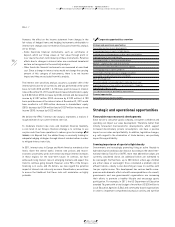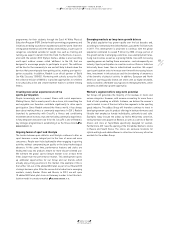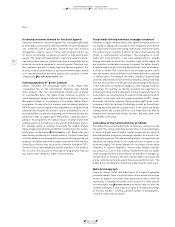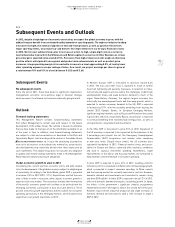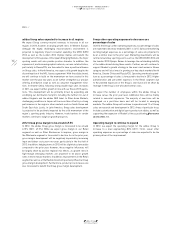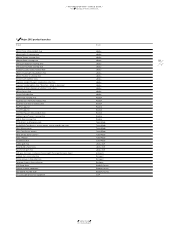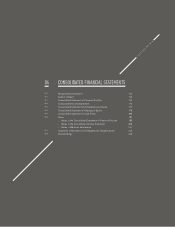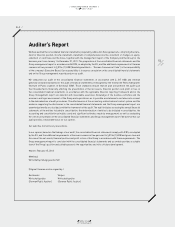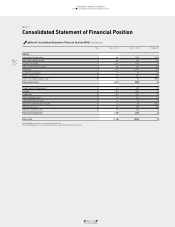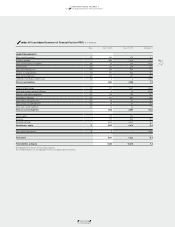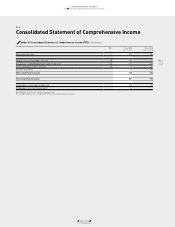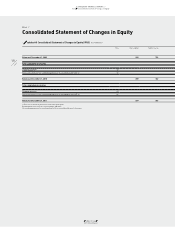Reebok 2011 Annual Report Download - page 172
Download and view the complete annual report
Please find page 172 of the 2011 Reebok annual report below. You can navigate through the pages in the report by either clicking on the pages listed below, or by using the keyword search tool below to find specific information within the annual report.
adidas Group
2011 Annual Report
GROUP MANAGEMENT REPORT – FINANCIAL REVIEW
168
2011
03.5 Subsequent Events and Outlook
03.5
adidas Group confident to deliver on long-term
strategic goals from 2010 to 2015
Based on the adidas Group’s strong brands, premium products,
extensive global presence and its commitment to innovation and the
consumer, the adidas Group aspires to grow its business significantly
until 2015. According to our strategic business plan Route 2015, total
Group sales are targeted to grow 45% to 50% on a currency-neutral
basis over the five-year period, thereby outperforming total market
growth (both GDP and sporting goods industry). In addition, we aim
to grow our bottom line faster than the top line. It is targeted to grow
annual earnings at a compound annual growth rate of 15% and to
reach an operating margin of 11% sustainably by 2015 at the latest.
For 2013, in line with our mid-term guidance, we project adidas Group
sales and net income to increase compared to 2012.
In order to reach our strategic goals and create long-term sustainable
shareholder value, we have defined clear strategic pillars. These
include:
– Clear market positioning and brand prioritisation: We believe that
we have significant growth potential to exploit from our portfolio of
brands. The majority of our targeted growth will come from Global
Brands, which we anticipate will contribute 90% of the Group’s
expected revenue increase over the period
SEE GLOBAL BRANDS STRATEGY,
P. 68
. Areas within the adidas and Reebok brands that have been
identified as key contributors to sustainable growth for the adidas
Group include:
– adidas Sport Performance: gaining sales and market share in the
running and basketball categories
– adidas Sport Style: expanding in the fast-fashion business with the
adidas NEO label
– Reebok: establishing Reebok as the leading fitness brand
– Leading the industry in the fields of customisation and interactivity
By brand, we expect adidas Sport Performance sales to grow at a
mid- to high-single-digit compound annual growth rate. We plan
to increase adidas Sport Style and Reebok sales at a double-digit
compound annual growth rate until 2015.
– Expand presence in key growth markets: We have identified North
America, Greater China, Russia/CIS, Latin America, Japan and the UK
as key growth markets. Of those markets, the three ”attack markets”
North America, Greater China and Russia/CIS are expected to
contribute around 50% of the total Group growth under the Route 2015
plan, with each market targeting a double-digit compound annual
growth rate. In the USA, the Group’s brands have enormous potential
to gain market share by focusing on improved distribution and allowing
a higher share of products to be specifically designed for that market.
In emerging markets such as China and Russia, rising standards of
living, increasing disposable income, positive demographic trends
and growing sports participation should support demand for sporting
goods.
– Intensify controlled space focus: We intend to increase the portion
of sales that comes from controlled space initiatives to at least
45% of Group sales in the coming years (2011: 36%). This includes
new openings of adidas and Reebok own-retail stores, the further
extension of our mono-branded franchise store base in markets such
as China, as well as new shop-in-shop initiatives with retail partners
around the world. In terms of our own retail, we intend to open at
least 550 adidas and Reebok stores over the five-year period, as well
as grow significantly our eCommerce business, which we project to
increase to € 500 million by 2015
SEE GLOBAL SALES STRATEGY, P. 62
.
– Leverage growth and operational scale through to bottom line: A
higher exposure to emerging markets as well as expanding controlled
space activities are important levers to improving brand presence,
increasing sell-through and driving higher Group profitability. In
addition, we continuously work on streamlining internal processes
to accelerate decision-making, reduce complexity and make our
organisation leaner and more efficient. Therefore, we believe there is
significant potential to increase the Group’s operating margin to 11%
sustainably by 2015.
– Maintain financial flexibility: We strive over the long term to
maintain a ratio of net borrowings over EBITDA of less than two times.
A strong balance sheet increases our flexibility to realise value-
generating medium- and long-term opportunities in the best interests
of our shareholders as they arise.


